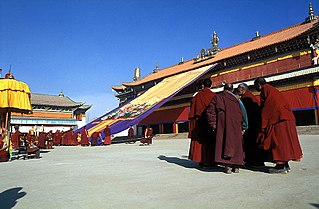
Ngawa or Aba town is the seat of Ngawa (Aba) County, within the Ngawa (Aba) Tibetan and Qiang Autonomous Prefecture in northwestern Sichuan, China. It is located on the Tibetan plateau at an elevation of 3,200 metres (10,500 ft). The city is about 75 km (47 mi) from Jigdril, 254 km from Barkham (Ma'erkang) and 157 km (98 mi) from Mewa (Hongyuan).
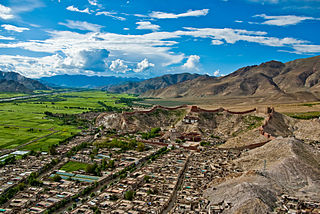
Gyantse, officially Gyangzê Town, is a town located in Gyantse County, Shigatse Prefecture, Tibet Autonomous Region, China. It was historically considered the third largest and most prominent town in the Tibet region, but there are now at least ten larger Tibetan cities.
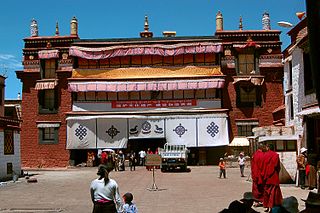
Ramoche Temple is a Buddhist monastery in Lhasa, Tibet Autonomous Region. It dates back to the seventh century and is considered to be the most important temple in the city after the Jokhang Temple. Situated in the northwestern part of the Tibetan capital, it is east of the Potala and north of the Jokhang. The site occupies an area of 4,000 square meters.

Tsetang or Zedang, is the fourth largest city in Tibet and is located in the Yarlung Valley, 183 km (114 mi) southeast of Lhasa in Nedong District of the Shannan Prefecture in the Tibet region of China. It is the capital of Shannan Prefecture.
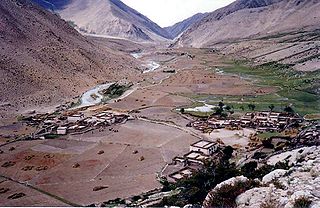
Milarepa's Cave or Namkading Cave is a cave where the Tibetan Buddhist philosopher, and Vajrayana Mahasiddha, Milarepa spent many years of his life in the eleventh century. It is located 11 kilometres (7 mi) north of the town of Nyalam at Gangka village. It is on the slope below the China–Nepal Friendship Highway and above the Matsang river in Nyalam County, Tibet.

Nyalam is a small town in and the county seat of Nyalam County in the Shigatse Prefecture of the Tibet Autonomous Region, near the Nepal border. It is 35 km from Zhangmu town in the same county, which is the point of entry to Nepal. Nyalam is situated at 3,750 metres (12,300 ft) above sea level.

Ngor or Ngor Éwam Chöden is the name of a monastery in the Ü-Tsang province of Tibet about 20 kilometres (12 mi) southwest of Shigatse and is the Sakya school's second most important gompa. It is the main temple of the large Ngor school of Vajrayana Buddhism, which represents eighty-five percent of the Sakya school.

Yumbu Lakhang or Yumbu Lakhar is an ancient structure in the Yarlung Valley in the vicinity of Tsetang, Nêdong County, the seat of Lhoka Prefecture, in the southern Tibet Autonomous Region of China.

The new town of Lhatse or Lhatse Xian, also known as Quxar (Tibetan: ཆུ་ཤར་, Quxia, or Chusar, is a small town of a few thousand people in the Tibet Autonomous Region in the valley of the Yarlung Tsangpo River in Lhatse County, 151 kilometres southwest of Shigatse and just west of the mountain pass leading to it. Lhatse is 4,050 metres above sea-level.
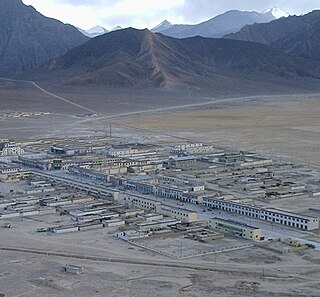
The Rutog Town , called Rituzhen in Chinese, is a town and the seat of Rutog County in the far western Tibet Autonomous Region. It is also a major military base for China near the disputed border with India allowing it to press its claims militarily.
Chokorgyel Monastery is a Buddhist monastery in Gyatsa County in Tibet.

Drongtse Monastery is a Tibetan Buddhist monastery was formerly one of the most important Gelug monasteries in Tsang, Tibet. There was also a chorten there.

Tsomon Ling, Tsomonling, Tsome Ling, Chomoling is a temple in inner Lhasa, Tibet Autonomous Region, China, south of the Ramoche Temple, and on the corner of one of the main roads, Dekyi Shar Lam. It was one of the Four Royal Colleges or Regency Temples of Lhasa built during the 17th century after the Fifth Dalai Lama assumed both temporal as well as spiritual power. The other three Ling are Tengye Ling, Kunde Ling, and Drib Tsemchok Ling.
Buchu Monastery, Buchu Sergyi Lhakhang, or Buchasergyi Lakang Monastery is a temple in an ancient monastery about 28 km south of the modern town of Bayi, which replaces the old village of Drakchi, in Nyingchi County of eastern Tibet.

Garzê or Ganzi, is a town and county seat in Garzê County, Garzê Tibetan Autonomous Prefecture in western Sichuan Province, China. Despite Garzê Prefecture being named after the town, the prefecture capital is Kangding, 365 km to the southeast. As of 2010, Garzê was home to 16,920 inhabitants. Garzê is an ethnic Tibetan township and is located in the historical Tibetan region of Kham. It contains the 15th century Kandze Monastery, home to over 500 Gelugpa monks.

Kandze Monastery is situated 2 km north of Garzê Town on a hilltop overlooking the town, in Tibet.

The Yarlung Valley is formed by Yarlung Chu, a tributary of the Tsangpo River in the Shannan Prefecture in the Tibet region of China. It refers especially to the district where Yarlung Chu joins with the Chongye River, and broadens out into a large plain about 2 km wide, before it flows into the Tsangpo River. It is situated in Nedong District of the Shannan Prefecture and includes the capital of the prefecture, Tsetang, one of Tibet's largest cities, 183 km southeast of Lhasa.

Tsechen Monastery, Tsechen Dzong or Shambu Tsegu, was about 5 kilometres (3.1 mi) northwest of Gyantse above the traditional village of the same name. Tsechen was the largest of a number of hilltop monastery-forts ringing the valley, none of which would be easy to assault. The fortress, or dzong, was considered to be almost as strong as the Gyantse Dzong. It was "built on another precipitous hill about 600 feet [183 metres] high, about one mile [1.6 km] long, and rising abruptly out of the plain occupied by at least 1,000 of the enemy who cheered vociferously when they saw us retire."

The Gonggar Dzong, also known as Gongkar Dzong, is located in Gonggar County, Shannan Prefecture, Tibet, China. It is close to the Gongkar town, the Gonggar Choide Monastery and the Gonggar Airport, 10 kilometres (6.2 mi) from the town. The Dzong is also known by names such as Kung-k’o, Chi-hsiung, K'ung-ka-tsung, Konka Dzong, K’ung-ka-tsung, Gongkar, Kung-k'o, Kung-ka, Gongkar Dzong, Kong-ka-dsong, Kongka Dzong and Gonggar.

The Shigatse Dzong, also known as Samdruptse Dzong, is located in Shigatse, Tibet, China. It is spelt Rikaze Dzong.




















